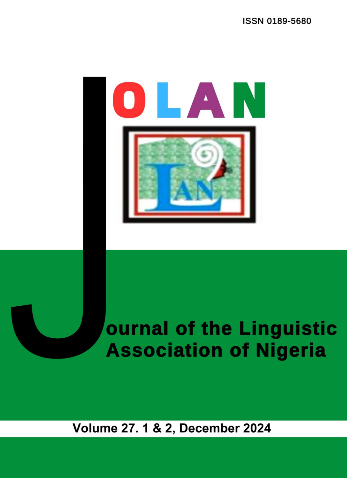A Sociolinguistic Description of Rhetoric in Anaañ and Ọrọ Traditional Settings
Keywords:
rhetoric, interactional sociolinguistics approach, systemic functional linguistics(SFL), Anaañ, ỌrọAbstract
This work centred on Rhetoric as an aspect used for effective communication by the Anaañ and Ọrọ speakers in Akwa Ibom State. Rhetoric is applied to persuade, influence and convince an audience for specific purposes. This paper, therefore, sought to analyse the sociolinguistic devices used in rhetoric in Anaañ and Ọrọ traditional settings, with the aim of showing the effects of these devices in the understanding of the message. Data for this paper was extracted from an ongoing research work on Anaañ and Ọrọ oral literature, using the framework of Halliday’s Systemic Functional Linguistics (SFL) and Interactional Sociolinguistics theories for analysis. Findings revealed that rhetorical language is commonly coloured with figurative expressions, proverbs, and metaphorical expressions, code mixing, convergence, with some forms of idiomatic expressions. Rhetoric was also used as a tool for inclusion and exclusion in communication in Anaañ and Ọrọ traditional settings. The paper is a contribution to the ongoing research on oral literature in the Lower Cross Languages. It established a basis for the understanding of the various rhetorical devices used in traditional societies in Akwa Ibom as well as Nigeria as a whole.
References
Aristotle (c 330 BC). "... rhetoric is a combination of the science of logic and of the ethical 1branch of politics ..." Aristotle. Rhetoric. (trans. W. Rhys Roberts). I:4:1359.;Aristotle, Rhetoric 1.2.1, [1] Archived 16 September 2008 at the Wayback Machine.
Connell, B. (1993). Phonetic Aspects of Lower Cross Languages and Implications for Sound Change. Ph.D Dissertation, University of Edinburgh
David, M (2004), "Pentateuchal Rhetoric and the Voice of the Aaronides", in Carol S. Lipson & Roberta A. Binkley, Rhetoric before and beyond the Greeks, State University of New York Press, pp. 165–82, ISBN0-7914-6099-1
Essien, O. E (1985b). Ibibio Othography. Ayo Banjo (ed) Orthographies of Nigerian Languages, Manual III, Lagos: National Language Centre.
Eyefoki, E (2004) Ekpu Statutes of Oron, Forms and symbolism, An Unpublished Ph.D thesis, University of Ibadan, Nigeria.
Farinde, R.O and Ojo, J.O (2005) Farinde, R.O & Ojo, J.O (2005). Introduction to Sociolinguistics. Ibadan: Lektay Publisher
Grumpez, J .J (1982) Discourse Strategies: Studies in Interactional Sociolinguistics. Cambridge: Cambridge University Press
Halliday, M.A.K (1978). Language as a Social Semiotic: The Social Interpretation of Language and Meaning. London: Edward Arnold.
Hymes, D. (1964). Language in Culture and Society: Readings in Linguistics and Anthropology_ New Yorks Harper and Row
Isong, M. (2012). The Language of Uda Political System. An Unpublished Undergraduate Project, University of Uyo, Uyo
Michael, I & Obot J.U. (2004) The Orthography of the Anaang Language Calabar: Anaang Community.
Udoh, I. (2003). An Introduction to Phonemic Analysis, Lagos: Concept Publications Ltd
Urua, E.E. (1996). Languages or Dialects? The Linguistic Situation in Akwa Ibom State, Uyo: Journal of Humanities vol 4pp50-54
Urua, E.E. (2000). Ibibio Phonetics and Phonolgy. M & J Grand Orbit Communication Ltd and Emhai press, Port Harcourt, Nigeria
Vickers, B. (1995). "Deconstruction's Designs on Rhetoric." Rhetoric and Pedagogy: Its History, Philosophy, and Practice. Ed.Winifred Bryan Horner and Michael Leff 295–315
William, W. H. (2004). "The Birth of Rhetoric", in Carol S. Lipson & Roberta A. Binkley, Rhetoric before and beyond the Greeks, State University of New York Press














